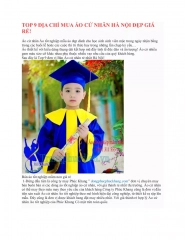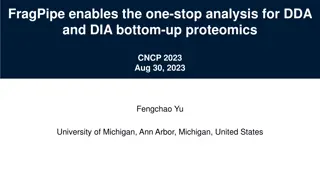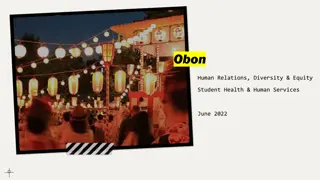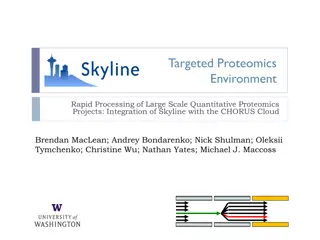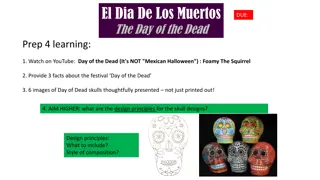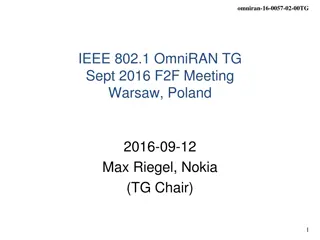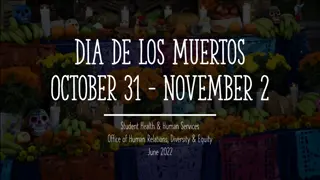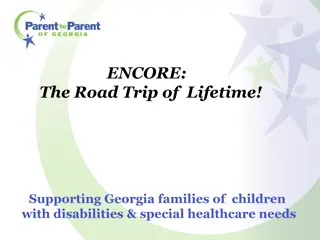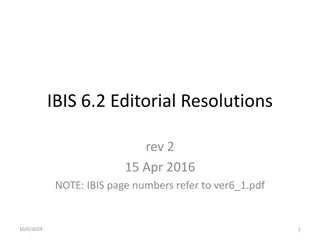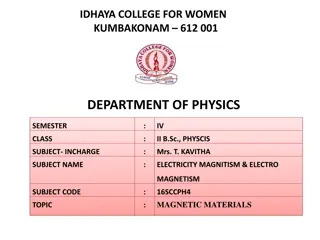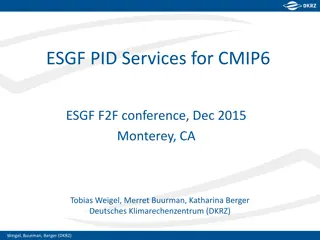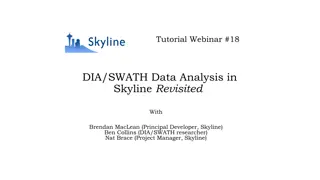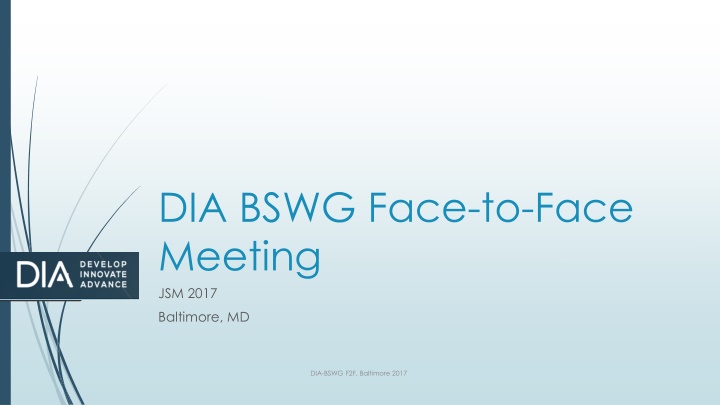
DIA-BSWG Face-to-Face Meeting 2017 in Baltimore
Explore the DIA-BSWG Face-to-Face Meeting in Baltimore 2017, where academia, industry, and regulatory partners collaborate on Bayesian methodology to enhance medical product development. The event features agenda insights, acknowledgments, vision & mission details, lead team introduction, subteams, and their chairs. Join representatives engaging in scientific discussions for innovative progress in Bayesian methods.
Uploaded on | 1 Views
Download Presentation

Please find below an Image/Link to download the presentation.
The content on the website is provided AS IS for your information and personal use only. It may not be sold, licensed, or shared on other websites without obtaining consent from the author. If you encounter any issues during the download, it is possible that the publisher has removed the file from their server.
You are allowed to download the files provided on this website for personal or commercial use, subject to the condition that they are used lawfully. All files are the property of their respective owners.
The content on the website is provided AS IS for your information and personal use only. It may not be sold, licensed, or shared on other websites without obtaining consent from the author.
E N D
Presentation Transcript
DIA BSWG Face-to-Face Meeting JSM 2017 1 Baltimore, MD DIA-BSWG F2F, Baltimore 2017
Acknowledgments 2 Face-to-face planning committee Freda Cooner, Sanofi Satrajit Roychoudhury, Pfizer Amy Xia, Amgen Karen Price, Eli Lilly Fanni Natanegara, Eli Lilly DIA-BSWG F2F, Baltimore 2017
Agenda 3 Overview Officers and Subteam Leaders Operations 2017 Objectives DIA-BSWG F2F, Baltimore 2017
Who we are? Academia-Industry-Regulatory partners 4 Group of representatives from Regulatory, Academia, and Industry, engaging in scientific discussion/collaboration facilitate appropriate use of the Bayesian approach contribute to progress of Bayesian methodology throughout medical product development DIA-BSWG F2F, Baltimore 2017
Vision & Mission of DIA-BSWG 5 Vision Ensure that Bayesian methods are well-understood, accepted, and broadly utilized for design, analysis, and interpretation to improve patient outcomes throughout the medical product development process and to improve decision making. Mission To facilitate the appropriate use of Bayesian methods and contribute to progress by: Creating a scientific forum for the discussion and development of innovative methods and tools. Providing education on, and promoting the dissemination of, methods and best practices for Bayesian methods. Engaging in dialogue with industry leaders, the scientific community, and regulators. And to foster diversity in membership and leadership. DIA-BSWG F2F, Baltimore 2017
Lead Team Chair: Fanni Natanegara Vice-Chair: Amy Xia Past Chair: Karen Price Secretaries: Qi Tang, Pritibha Singh Publication Chairs: Freda Cooner, Samiran Ghosh Webmaster: Frank Liu Chairs of each Subteam (next page) DIA-BSWG F2F, Baltimore 2017
Subteams and Chairs 6 Safety: Melvin Munsaka (melvin.munsaka@takeda.com), Karen Price (price_k@lilly.com), Amy Xia (hxia@amgen.com) Education: Fanni Natanegara (natanegara_fanni@lilly.com), Mat Davis (Matthew.Davis07@tevapharm.com) Medical outreach: Jennifer Clark (Jennifer.Clark@fda.hhs.gov] , Ross Bray (bray_ross@lilly.com) Best practice: Cory Heilmann (heilmann_cory_r@lilly.com) Historical data/prior specification: John Zhong john.zhong@biogen.com) and Satrajit Roychoudhury (satrajit.roychoudhury@pfizer.com) Non-inferiority: Mani Lakshminarayanan (mani.lakshminarayanan@pfizer.com) Standards/Reporting: Mani Lakshminarayanan Missing Data: Frank Liu (guanghan_frank_liu@merck.com), Stacy Lindborg (stacy.lindborg@biogenidec.com) Benefit/Risk: Carl DiCasoli (cdicasoli@celgene.com) Program-wide decision making: Bin Yao (BYao@pumabiotechnology.com) and Karen Price Joint with Pediatric community and ADSWG: Meg Gamalo (gamalo_margaret@lilly.com) MAPP (Medicine Adaptive Pathways to Patients): Larry Gould (larry_gould@merck.com), Zoran Antonevic (zorana@amgen.com), Bob Campbell (robert_campbell@brown.edu) Joint Modeling: Larry Gould (larry_gould@merck.com)
Operations and Past Work 7 Operations: Annual face to face meetings Quarterly group meetings Quarterly subteam leader meetings Establish charter for each subteam Subteam meetings at the discretion of each chair/co-chairs Past work 4 publications in Pharm Stats special issue 2014 Other publications: Joint modeling (SIM); Safety signal detection (DIAJ); Missing data (SBR); Noninferiority (JBS); Bayesian Extrapolation in Peds Drug Dev (Pharm Stats) Multiple sessions and short courses at DIA, DIA/FDA, JSM, Deming, ASA webinar, BASS Joint DIA ADSWG and BSWG conference 2015
2017 Objectives Showcase good projects with good science via case examples Gain acceptance in medical community Ensure Bayesian methods are applied appropriately including reproducibility (develop guidance related to simulations for Bayesian designs) Leverage 21st Century Cures Act and PDUFA VI Continue progress with each subteam Enhance and grow website: bayesianscientific.org Host Bayesian KOL lecture series Develop a book Bayesian Applications in Pharmaceutical Development Find opportunities for collaboration with DIA ADSWG DIA-BSWG F2F, Baltimore 2017
Historical Data/Prior Specification Subteam Update 10 Chairs: John Zhong and Satrajit Roychoudhury Bayesian book chapter under development Being able to borrow information from previous studies is an appealing and exciting property of Bayesian methods. However, such a use of historical information in confirmatory trials is always a challenge because the underlying assumption of exchangeable is difficult to be shown. This chapter will discuss considerations of integrating historical information into confirmatory trials from a practical perspective. Actively participate in Bio iCT (Innovative Clinical Trial) Workforce arming to influence regulatory policy change to broadly accept Innovative Clinical Trial in confirmatory stage DIA-BSWG F2F, Baltimore 2017
Safety Subteam Update 11 Chairs: Karen Price, Amy Xia, Melvin Munsaka The subteam is focusing on two topics namely: Making the case for Bayesian meta-analysis in safety data, and Extending the Bayesian hierarchical models for safety signal detection in clinical trials to multiple treatment and meta-analysis settings Develop a manuscript for each of the two topics DIA-BSWG F2F, Baltimore 2017
MAPPs (Medicine Adaptive Pathways to Patients) Subteam Update Chairs: Zoran Antonijevic, Larry Gould, Bob Campbell 17 cross-functional members; collaboration with ADSWG Completed charter document including specific tasks and impact to key stakeholders Publication strategy document under development Statistical foundations for MAPPs1-3 MAPPs relate to the entire life cycle of a medicine from development, through licensing to patient access (reimbursement and healthcare delivery) . Balance early patient access, public health and societal benefits Early authorisation of a product focused on a well-defined and targeted population with a clear safety and efficacy profile Target population is adjusted as the evidence base expands 1 MAPPs summary from http://efpiamapps.eu 2 Eichler, HG, et al. From adaptive licensing to adaptive pathways: delivering a flexible life-span approach to bring new drugs to patients. Clin. Pharmacol. Ther. 2015 Mar;97(3):234-246. PubMed PMID: 25669457 3Eichler, HG, et al. Adaptive licensing: taking the next step in the evolution of drug approval. Clin. Pharmacol. Ther. 2012 Mar;91(3):426-37. PubMed PMID: 22336591 DIA-BSWG F2F, Baltimore 2017
Medical Outreach Update Chairs: Jennifer Clark and Ross Bray 10 cross functional members; collaboration with ADSWG Goal: coordinate and provide adaptive and Bayesian educational support which will help our medical colleagues to implement adaptive and Bayesian approaches in drug development on a more regular basis as appropriate. We intend to provide education at a variety of levels, i.e., to meet the needs of medical colleagues working in different organizations. Charter document close to completion Future work: focus groups with medical colleagues, create and distribute survey DIA-BSWG F2F, Baltimore 2017
Best Practice Subteam Update 14 Chair: Cory Heilmann 8 members; collaboration with ADSWG Bayesian book chapter under development The increase in use and acceptance of Bayesian methodology in clinical trials has led to a need for guidance on how to report and document such methodology. ICH and various regulatory agencies recommend including language regarding the planned analyses for primary and other key analyses in the protocol and in a pre-specified analysis plan. This chapter recommends the level of detail to include in protocols and analysis plan. Additionally, as the majority of Bayesian analyses involve simulation instead of closed form analyses, this chapter provides guidance on information to be included in a simulation plan and simulations report to support study design. DIA-BSWG F2F, Baltimore 2017
Bayesian KOL Lecture Series Organizing committee: Kert Viele, Mathangi Gopalakrishnan, Amy Xia, Karen Price, Mani Lakshminarayanan, John Scott, Fanni Natanegara Focus on interesting methodology, case studies, and communication within sponsors as well as regulatory aspects Webinar series started in June 2017! Presentation from Dr. Scott Berry on Bayesian Methods in Pharmaceutical Development and Clinical Trial Design . Nearly 120 lines were used; few lines had a group of people joined in a room 2hr was well spent with presentation, case examples, and ample time for QA Operations: Every 3rd Friday 11-1pm EST Teleconference and webconference provided; free of charge Slide deck will be posted on http://www.bayesianscientific.org/kol-lecture-series/ Suggestions for topics or speakers from anyone are welcome! DIA-BSWG F2F, Baltimore 2017
Bayesian Applications in Pharmaceutical Development 16 Editors: Mani Lakshminarayanan and Fanni Natanegara Introduction [Fanni Natanegara, Mani Lakshminarayanan] Building prior On incorporation of historical control data in clinical trials [G. Frank Liu, Wen Li, Larry Gould] Practical considerations for building prior [John Zhong, Guochen Song, Baoguang Han, Stacy Lindborg] Leveraging expert knowledge to develop robust informative prior belief distributions to aid decision making in drug and medical device development [Karen Price, Tim Montague] Discovery/Preclinical phase Use of Bayesian Methods for In Vivo Assays Developments & Use [Benoit Beck, Phil Iversen] Clinical phase Bayesian methods for dose response study [Neal Thomas] Executing and Reporting Clinical Trial Simulations: Practical Recommendations for Best Practices[Cory Heilmann, Fanni Natanegara, Matilde Sanchez-Kam, Maria Costa, John Seaman, Radha Railkar, Karen Price, Meg Gamalo] Reporting of Bayesian Analyses in Clinical Research: Some Recommendations [Melvin Munsaka, Mani Lakshminarayanan] Handling missing data in clinical trials with Bayesian and imputation approaches [Xin Zhao, Neal Thomas, Stacy Lindborg and Frank Liu] Bayesian Probability of Success Estimation for Go / No-Go Decision-Making [Qi Tang, Alan Hartford] DIA-BSWG F2F, Baltimore 2017
Bayesian Applications in Pharmaceutical Development 17 Product Development Bayesian Assurance in the Process Validation Life-Cycle [Paul Faya, John W. Seaman, Jr, James D. Stamey] Regulatory Overview of Bayesian Application [Lei Huang, Telba Irony] Computational tools Bayesian computation tools [David Kahle, Michael Sonksen] Software Tools for Bayesian Analysis [Melvin Munsaka, Michael Sonksen, Richard Zink] Special topics Rare disease: Bayesian Applications Empowered by Natural History Data for Rare Diseases Drug Development [Shu Han] Pediatric: The challenges and advantages of utilizing Bayesian statistical methodology in the extrapolation of adult efficacy data to pediatric study design and evaluation [Meg Gamalo] Personalized treatment selection rules based on predictive probability [Brian Hobbs, Junshen Ma, Francesco Stingo] DIA-BSWG F2F, Baltimore 2017
How to get involved? 18 To join the DIA Bayesian Scientific Working Group please contact Fanni Natanegara at natanegara_fanni@lilly.com Contact any subteam chairs Start a subteam Further information: bayesianscientific.org Collaboration with ADSWG DIA-BSWG F2F, Baltimore 2017
Opportunities to Collaborate between BSWG and ADWG 19 DIA-ADWG F2F, Baltimore 2017
Opportunities for Collaboration From discussions among leadership: Joint workshops with FDA targeted for late 2018 Historical controls together with Transcelerate Adaptive Designs, Bayesian Methods, and Real World Data in Confirmatory Setting in Oncology together with American Society of Clinical Oncology and FDA Oncology Center of Excellence Both workshops will attempt to attract clinicians and other key stakeholders and decision-makers 19
Opportunities for Collaboration (II) 20 Some sub working groups may fuse Medical outreach Expedited approvals Best practices Survey for the use of adaptive design in medical device Building case examples (currently hosted by the DIA website) Website New opportunities for collaboration will hopefully be suggested by BSWG and ADSWG members! It would be great to form NEW working groups

